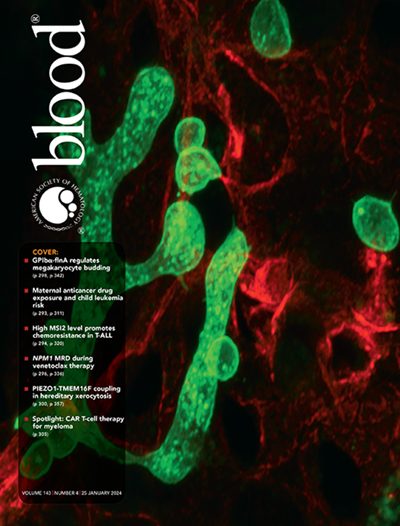Inflammasome-resistant IPSC-derived myeloid-derived suppressor cells ameliorate xenogeneic graft-versus-host disease.
IF 23.1
1区 医学
Q1 HEMATOLOGY
引用次数: 0
Abstract
Front-line pharmaceutical treatment for treatment of acute graft-versus-host disease (aGVHD) is not uniformly effective and has toxic side effects. Myeloid-derived suppressor cells (MDSCs) are a heterogeneous population of immature myeloid cells with potent in vitro and in vivo immunosuppressive functions. Clinical translation of in vitro generated MDSCs has been limited by the need for high MDSC:T cell ratios, multiple infusions to reduce inflammation and a relatively low peripheral blood-derived MDSC (PB-MDSCs) yield. To circumvent these obstacles, we developed a methodology to generate MDSCs using human induced pluripotent stem cell (iPSC)-derived CD34+ cells. Compared to PB-MDSCs, iPSC-MDSCs (iMDSCs) shared similar morphology, phenotype, and suppressive function. We found that the CD14+ iMDSC subset possessed the highest suppressor function. In previous studies, we reported that MDSCs transferred on day 0 into mice undergoing GVHD lost suppressor function due to inflammasome activation and immature myeloid cell maturation1. In striking contrast to human PB-MDSCs, we show here that iMDSCs retained 95% of suppressor function in vitro despite exposure to LPS+ATP, danger-associated molecular patterns inflammasome activating stimuli released early post-transplant during conditioning and GVHD-induced injury. When transferred in vivo with PB mononuclear cells, iMDSCs significantly increased recipient survival without loss of anti-leukemia effects. iMDSC RNAseq and gene knockdown studies revealed that the maintenance of the purine metabolizing enzyme, phosphoglycerate dehydrogenase, during LPS+ATP was linked to iMDSC inflammasome resistance. Taken together, these data provide a platform for translating in vitro generated, off-the-shelf iMDSCs into the clinic for suppressing a spectrum of adverse immune responses including GVHD.ipsc衍生的抗炎性小体髓源性抑制细胞改善异种移植物抗宿主病
治疗急性移植物抗宿主病(aGVHD)的一线药物治疗并不统一有效,并且具有毒副作用。髓源性抑制细胞(MDSCs)是一种异质的未成熟髓细胞群,在体外和体内具有强大的免疫抑制功能。体外生成的MDSCs的临床转化受到高MDSC:T细胞比例、多次输注以减少炎症和相对较低的外周血源MDSC (PB-MDSCs)产量的限制。为了克服这些障碍,我们开发了一种利用人类诱导多能干细胞(iPSC)衍生的CD34+细胞生成MDSCs的方法。与PB-MDSCs相比,iPSC-MDSCs (imdsc)具有相似的形态、表型和抑制功能。我们发现CD14+ iMDSC亚群具有最高的抑制功能。在之前的研究中,我们报道了在第0天转移到GVHD小鼠体内的MDSCs由于炎性体激活和未成熟的髓细胞成熟而失去抑制功能1。与人类PB-MDSCs形成鲜明对比的是,尽管暴露于LPS+ATP、危险相关分子模式、移植后早期在调节和gvhd诱导的损伤过程中释放的炎性体激活刺激,iMDSCs在体外仍保留了95%的抑制功能。当与PB单核细胞一起在体内转移时,imdsc显着增加了受体的生存而不丧失抗白血病的作用。iMDSC RNAseq和基因敲低研究表明,在LPS+ATP过程中嘌呤代谢酶磷酸甘油酸脱氢酶的维持与iMDSC炎性体抵抗有关。综上所述,这些数据为将体外生成的现成imdsc转化为临床抑制包括GVHD在内的一系列不良免疫反应提供了一个平台。
本文章由计算机程序翻译,如有差异,请以英文原文为准。
求助全文
约1分钟内获得全文
求助全文
来源期刊

Blood
医学-血液学
CiteScore
23.60
自引率
3.90%
发文量
955
审稿时长
1 months
期刊介绍:
Blood, the official journal of the American Society of Hematology, published online and in print, provides an international forum for the publication of original articles describing basic laboratory, translational, and clinical investigations in hematology. Primary research articles will be published under the following scientific categories: Clinical Trials and Observations; Gene Therapy; Hematopoiesis and Stem Cells; Immunobiology and Immunotherapy scope; Myeloid Neoplasia; Lymphoid Neoplasia; Phagocytes, Granulocytes and Myelopoiesis; Platelets and Thrombopoiesis; Red Cells, Iron and Erythropoiesis; Thrombosis and Hemostasis; Transfusion Medicine; Transplantation; and Vascular Biology. Papers can be listed under more than one category as appropriate.
 求助内容:
求助内容: 应助结果提醒方式:
应助结果提醒方式:


